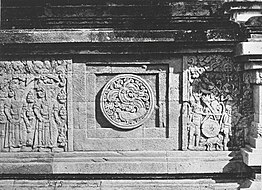
Back صنجة Arabic Gong BAR Гонг Bulgarian Kanung BJN Gong Catalan Gong Czech Gongong Danish Gong German Tagung DTP Γκονγκ Greek
 | |
| Classification | Metallophone |
|---|---|


A gong[note 1] is a percussion instrument originating from Southeast Asia, and used widely in Southeast Asian and East Asian musical traditions. Gongs are made of metal and are circular and flat or bowl-like in shape, and can come in various sizes. They are typically struck with a mallet. They can be played alone, giving a characteristic "crashing" sound, or played as part of a tuned set that produce bell-like sounds.
The earliest possible depictions of gongs is from the details on the surface of the Ngọc Lũ I bronze drum (c. 3rd to 2nd century BC) from the Dong Son culture of northern Vietnam. It depicts what looks like seven-gong ensembles along with other instruments (including cymbals/bells and the bronze drums themselves).[1] The oldest undisputed historical mention of gongs can be found in sixth century AD Chinese records, which mentioned it as a foreign instrument that came from a country between Tibet and Burma. The term gong (Javanese: ꦒꦺꦴꦁ) originated in the Indonesian island of Java. Scientific and archaeological research has established that Annam, Java, Burma, and Southern China were the four main gong manufacturing centres of the ancient world.[2][3] The gong found its way into the Western World in the 18th century, when it was also used in the percussion section of a Western-style symphony orchestra.[4] A form of bronze cauldron gong known as a resting bell was widely used in ancient Greece and Rome: for instance in the famous Oracle of Dodona, where disc gongs were also used.[5][6]
Gongs generally fall into three types: Suspended gongs are more or less flat, circular discs of metal suspended vertically by means of a cord passed through holes near to the top rim. Bossed or nipple gongs have a raised centre boss or knob and are often suspended and played horizontally. Bowl gongs are bowl-shaped and rest on cushions. The latter may be considered a member of the bell category. Gongs are made mainly from bronze or brass, though there are many other alloys in use.
Gongs produce two distinct types of sound. A gong with a substantially flat surface vibrates in multiple modes, giving a "crash" rather than a tuned note. This category of gong is sometimes called a tam-tam, to distinguish it from the bossed gongs that give a tuned note. In Indonesian gamelan ensembles, some bossed gongs are deliberately made to generate an additional beat note in the range from about 1 to 5 Hz. The use of the term "gong" for both these types of instrument is common.
Cite error: There are <ref group=note> tags on this page, but the references will not show without a {{reflist|group=note}} template (see the help page).
- ^ Tran, Hoai (3 August 2022). Doing "Gong Culture" Heritage Politics and Performances in the Central Highlands of Vietnam. Lit Verlag. p. 63. ISBN 9783643914064.
- ^ Blades, James (1992). Percussion Instruments and Their History. Bold Strummer. p. 93. ISBN 978-0933224612.
The origin of the gong is uncertain, but there seems little reason to doubt the claim of the Chinese whose tradition ascribes it to the country Hsi Yu between Tibet and Burma, where it is mentioned early in the sixth century in the time of Emperor Hsüan Wu (AD 500-515).
- ^ Jaap Kunst (11 December 2013). Music in Java: Its history, Its Theory and Its Technique (2 ed.). Springer. pp. 146–. ISBN 9789401771306. OCLC 1066191713.
the mountain tribes, now living in Southern China and Further India
- ^ Schlesinger 1911.
- ^ Montagu, Jeremy (2007). Origins and Development of Musical Instruments. Scarecrow Press. pp. 16–17. ISBN 9780810856578. OCLC 123539614.
- ^ Cook, Arthur Bernard (1902). "The Gong at Dodona". The Journal of Hellenic Studies. 22: 5–28. doi:10.2307/623918. JSTOR 623918. S2CID 163626553.